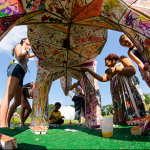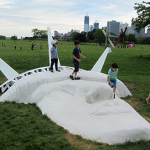“FIGMENT catalyzes and celebrates an abundance of creativity and passion, challenging artists and our communities to find new ways to create, share, think, and dream.”
Figment is happening this weekend on Governors Island in NYC, and in cities across the country over the coming months. This amazing event fuses art and interactive design in unique and surprising ways. Cloudberry’s principal, Greg Gallimore, sat down with David Koren, the Founder and Executive Director to discuss Figment. Here is a bit of their conversation:
Greg: So, how did it start? Back in 2007?
David: Yes – 2007 was the first Figment on Governor’s Island in New York City. I first went out to Governor’s Island in 2005 … and I was just blown away by the place. It’s an amazing place. And as I started to research it, I learned that there can be no permanent housing there. So the city has 172 newly acquired acres but no one can live there. So how do you develop a part of the New York City where no one can live?
So I immediately thought, the arts have to be a part of developing what this is about. I started talking to friends who I knew mostly through Burning Man about creating some kind of arts thing out there and developed the idea for the festival.
We told the island we were going to do this one day event and have maybe 200, maybe 500 people turn up. The New York Times got wind of it, and wrote an article in the Friday Weekend Section, which I think was July 6th, 2007, and they called it “Burning Man East”. We had sixty arts projects installed out there and 5,000 people showed up which freaked out the island managers and they shut the ferries down in the early afternoon and said, “that’s it – no more people can come”. So we turned away 2,000 people. Everybody loved the event … so we started this annual kind of progression on Governor’s Island.
Greg: And what’s the expected turn-out this weekend?
David: It’s been about 25,000 the last three/four years, so it will depend on weather. It’s definitely dependent on weather, but I’d say somewhere in that range.
Greg: For a 2 day event?
David: Yeah, Yeah. It’s 10-15,000 a day.
Greg: Wow.
David: They come out and it’s something like 250 arts projects that are all interactive.
Greg: One of the missions that we find really interesting as it relates to Children’s Museums design is how there is a permission to do things there that you normally wouldn’t do, and that there is no barrier to entry. How were those core principles for you, starting this?
David: Well, that was the experiment, right? Can we take this island that no one knows what to do with, and kind of create a different environment there where things are possible that aren’t possible in Lower Manhattan. And so it’s this journey; you get on the boat and go to this place of possibility and then you get there and it’s like, oh, I can do things here…the rules are different. I can do things here that I couldn’t do over there. And that’s been a part of it from the beginning and I think we really have changed, to a large extent, what the island means to people and what kinds of things can happen there, but there’s a downside to that too, in that there’s kind of a “mob mentality” that takes over.
It will feel like they can touch or interact with anything, and often someone’s work will get destroyed because people are just playing with it too much. Because it’s not like going to a museum where default mode is, “I can’t touch anything.” Default mode is, “I can do anything to it”. So it’s interesting to try to manage that.
Greg: How much of the audience is children and how much of the art and activities is geared towards children?
David: We try to curate work that’s geared for everyone. What you have with interactive work, is that kids are used to playing and adults aren’t. Adults are used to a lot of boundaries, so what you often have is there will be kids will be dragging their parents like, “hey mommy, come play with me on this thing”. So it will be kids and adults playing and not really segregated from one another.
As soon as you engage with something, you’re hooked. As soon as you have that experience of getting in the rose petal pool, or playing with brain pong, you go, “oh my God, this is awesome, because I’m actually engaging with the art. I’m engaging with other people. The artist is there and I’m having a conversation with the artist.” You go deeper and deeper into the experience, and really, what that’s doing is we’re teaching each other to play. In real time, we’re making new human connections that aren’t about an economic transaction. They’re about shared interest. They’re about joy and enjoying the day together. And you kind of get that together and it explodes, and you both leave that interaction and go off and share that experience with other people and engage in the next thing.


